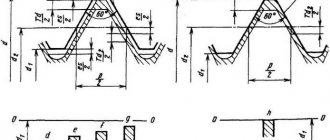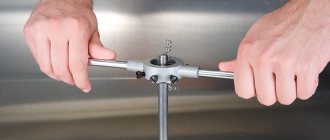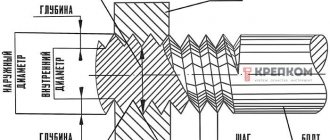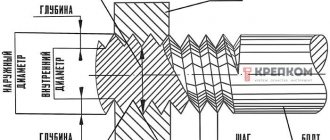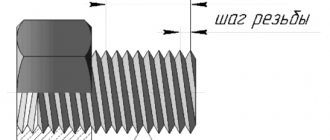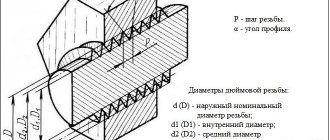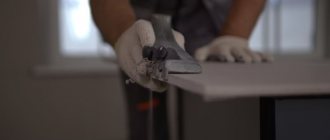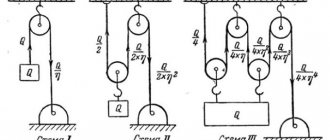For threaded connections of steel pipelines, couplings with internal threads are used, but even if sections of the pipeline fit closely to each other, it will not be possible to connect them with one part (unless it is an American one with a union nut) due to the same thread direction. For these purposes, intermediate sections are used - pipe bends, the dimensions and material of which are regulated by GOST.
When installing a water or gas main from metal pipes yourself, you will need to connect the pipelines to plumbing fixtures or gas equipment. For safe and correct installation of the system, it is useful to know the basic dimensions, materials and methods of manufacturing this element of plumbing fixtures.
Fig. 1 Squeegees for pipes in heating systems, water supply and gas pipelines
Specifications
The squeegee looks like a piece of pipe with threads on both sides. The segment must be straight or angular. On the short side, the thread consists of 5 turns, and on the long side, it consists of 20 turns or more, up to 30. The short end of the thread is connected to the pipe of the equipment, for example, a gas boiler or battery, and the long end is connected to another pipe. A coupling of a selected size with a lock nut also “goes” along the long thread.
The bends are made of metal, often “reinforced” with a zinc coating. If you require a decent appearance of pipes, it is possible to purchase elements with nickel plating. Often two numbers are indicated on the marking of the run, for example, 75/76. This says that the outer diameter of the product is 76 millimeters and the inner diameter is 75 millimeters.
The parameters (the length of the threads, its diameter and the size of the thread in inches) must be observed in accordance with GOST and correspond to the dimensions of the installed pipeline, for example, 25 millimeters (1 inch). The maximum diameter of the drive is 50 millimeters, the minimum is 15 millimeters. If the diameter of the pipeline itself is larger, then the solution to the problem is achieved through the use of flanges.
The maximum length of the fitting is 160 millimeters (for a diameter of 50 mm), and the minimum is 110 millimeters (for a diameter of 15 mm). These indicators can again be found in GOST. However, in practice, reality often does not meet the standards, so it is better to measure everything yourself and buy parts of the required length.
There is a classification of surges depending on the scope of their application: short, long and compensating. The latter are used for plumbing fixtures, batteries and other devices in order to minimize deviations within 5 centimeters detected during installation. The length of short runs is from 10 to 15 centimeters, and long ones are about 30 centimeters. The length of the compensating slopes varies from 13 to 17 centimeters.
The long thread of the short type is from 5 to 9 centimeters, and the short thread is from 9 to 17 millimeters. In general, the dimensions of the short side are the same for all types of bends. The long side of long bends also varies from 5 to 9 centimeters. The long side of the compensating surges ranges from 7.5 to 10 centimeters.
The main advantages of using squeegees include:
- simple installation without a welding machine;
- no need to invite a specialist;
- the appearance of a special unit that simplifies disassembly in case of need for repair, cleaning or replacement.
Among the disadvantages is the likelihood of a leak due to a lack of tightness.
Dimensions of bends according to GOST
The diameter of the steel pipes exactly matches the dimensions of the pipeline being installed. The weight of steel bends depends on their length. The sizes are standardized and shown in the table below.
| Conditional bore, mm | Thread type | Outer diameter, inch | Length of the short part, mm | Length of the long part, mm | Total length, mm | Weight, g |
| 10 | Pipe | ¼ | 8 | 40 | 90 | 62 |
| 15 | Pipe | ½ | 9 | 42 | 110 | 94 |
| 20 | Pipe | ¾ | 10,5 | 45 | 120 | 134 |
| 25 | Pipe | 1 | 11 | 50 | 130 | 243 |
| 32 | Pipe | 1 ¼ | 13 | 55 | 140 | 336 |
| 40 | Pipe | 1 ½ | 15 | 60 | 150 | 463 |
| 50 | Pipe | 2 | 17 | 65 | 160 | 608 |
At the customer's request, the bends can be manufactured with a nominal bore of 65 and 80 mm.
Types of pipes for production
Pipes used in water supply systems, heating systems, and gas pipelines are called water-gas pipelines (WGP). The use of VGP steel pipes with different wall thicknesses is determined by operating conditions. The following types of products are distinguished:
The weight of the products depends on the type of pipe used. For production, steel pipes GOST 3262-2010 are used.
| Outer diameter, inch | Pipe wall depending on the type of flow, mm | Weight depending on the type of drive, kg | ||||
| lungs | ordinary | reinforced | lungs | ordinary | Reinforced | |
| ¼ | 2 | 2,2 | 2,8 | 0,132 | 0,143 | 0,175 |
| ½ | 21,3 | 2,5 | 2,8 | 0,207 | 0,229 | 0,256 |
| ¾ | 2,5 | 2,8 | 3,2 | 0,268 | 0,297 | 0,333 |
| 1 | 2,8 | 3,2 | 4 | 0,379 | 0,428 | 0,521 |
| 1 ¼ | 2,8 | 3,2 | 4 | 0,489 | 0,553 | 0,677 |
| 1 ½ | 3 | 3,5 | 4 | 0,596 | 0,688 | 0,777 |
| 2 | 3 | 3,5 | 4,5 | 0,762 | 0,874 | 1,103 |
Correct installation of the American
American plumbing is installed using adjustable, open-end and universal wrenches. Also, sometimes you may need a special round key, which American women use to tighten them from the inside. The use of gas keys is prohibited. Excessive force applied to the handles of the gas wrench can deform the union nut.
Let's look at how to install an American pipe onto a pipe.
An American with internal thread is installed on two sections of the existing pipeline. If there is no thread on the pipe, then it is cut using a die. A sealant is wound onto the threads of one section. This can be FUM tape, flax fibers or other materials. After this, one part of the American is screwed onto the pipe using a wrench. Then a sealant is applied to the second threaded section, after which the second American fitting with a nut is screwed onto it. After which the two sections of the pipeline are connected to each other by tightening the union nut of the fitting.
Installation of an American with external thread is carried out almost the same way. The difference is that the seal is screwed onto the American thread itself.
As you can see, the use of American-type connecting elements can significantly speed up and simplify the process of installation and possible dismantling of pipelines and other plumbing fixtures.
Features of the American fitting
The American for plumbing is a collapsible design, a combined coupling of two threaded fittings and a union nut.
It can be flat and when used, the tightness of the connection is ensured by the gasket. The product is compact and affordable. During operation, it may be necessary to tighten the nut and replace a worn-out gasket, so it is not advisable to make such a connection hidden.
There is another version of the element - American cone. In this case, a gasket is not needed, since the polished parts of the cone-shaped fittings fit together as closely as possible during the process of tightening the nut.
The deviation along the axis of the pipes being laid should not exceed 5 degrees. They must be carefully checked for hidden defects. When creating critical connections that will operate under conditions of temperature differences in devices such as, for example, a water heater, you should use the cone version.
Thanks to the American, they are switching to a pipe that has a different diameter or is made of a different material. With its help you can make an angular type of connection.
The ease of use of this part has led to a number of plumbing manufacturing companies using it as a mounting product for metering devices, branded faucets, filters and other products.
To make an American fitting, you can use the following materials:
- cast iron;
- stainless steel;
- brass with nickel or chrome plated;
- metal-plastic.
In the latter case, a combination of polypropylene and stainless steel is used - such products are used when installing plastic risers.
Depending on the presence of external or internal threads, the following types of American threads are distinguished:
- coupling coupling;
- thread coupling;
- thread-thread.
American-type connections are produced for all popular sizes of pipe products. The most popular parameters are 1/2 and 3/4 inches.
Application
Examples
Where can you find sgons?
- After valves on steel connections, water supply and heating risers. They provide the ability to replace shut-off valves if they malfunction. In addition, thanks to the sweep, the pipe can be opened for cleaning (alas, steel pipes over decades of use become overgrown with rust and lime deposits);
- On connections to heating devices. First of all, to the already mentioned cast iron batteries: modern radiators are often mounted on other quick-release fittings - American ones;
Installation of squeegees
Connection with plastic pipes
Connecting plumbing components using plumbing fittings is considered simple: installing the element does not require special skills or practice.
Elements for water are fundamentally different in that the threads in them are located on the outside, and they must be covered with an anti-corrosion layer. This type of connection is considered detachable: it will be appropriate in the event that in the future there may be a need to disassemble part of the pipeline.
The drive, coupling and locknut assembly must be connected tightly and efficiently so that leaks do not occur in the future and tightness is ensured.
Installation of connecting elements for pipes and general assembly of the water supply system is carried out in several stages:
- A coupling is screwed onto one of the edges of the pipe.
- A drive is attached to the coupling. You need to screw in the part to the maximum. The side with the shorter thread should be used.
- A locknut is screwed to the opposite side. A connecting fitting is fixed to it, which is usually used in places where the diameter of the pipes is different, or where the pipe branches.
- The end of the drive is adjusted to the pipe, after which the coupling is screwed together, which should go onto the pipe.
- At the end of the work, the locknut is tightened to the coupling so that they are separated from each other at a distance not exceeding three centimeters. To secure, fill this free space with a sealant, for example, plumbing tow with grease or paste.
If you need to dismantle the installed section of the pipe, you should first unscrew the nut, then the coupling, and finally remove the bend.
Pipeline assembly technology
To assemble the pipeline, you must perform the following sequence of actions:
- First, screw the coupling onto the pipe.
- Then the side with the short thread is screwed into the coupling (sometimes it is connected directly). The parts should be screwed all the way, then the connection will be reliable.
- A locknut is screwed onto the long side of the drive.
- Next comes the connecting fitting.
- Then the end of the drive is applied to the pipe and the coupling is screwed together so that it goes onto the pipe. The connection will be easier to complete if the axes of the parts coincide as much as possible.
- The fitting must then be secured with a locknut. To do this, it should be screwed to the coupling so that there is a distance of 2-3 cm between the parts. This space must be filled with strands of flax. They should be wound in the direction of rotation of the nut. Then the locknut should be tightened until it stops. This must be done to seal the connection and prevent water leakage through it. You should use a wrench to tighten the locknut because its edges are narrow.
Connection device with squeegee
Connecting a pipeline using a product involves using a coupling (one or two) and a lock nut in the design. The end at which the short-length thread is screwed into a faucet or other device. Then the locknut and coupling are screwed onto it. Then the coupling is screwed onto the pipeline; the nut prevents the coupling from unscrewing. The price of such a kit depends on the material.
The cheapest are cast iron and steel products. They have a certificate of conformity, like imported products.
To seal joints, the following are used: for threads - flax, sealant, fum tape, on the outside - varnish or paint with a short drying time. Reversing the thread causes leakage at the joint with a high probability. To hold the valve in the desired position, use two keys.
The problem area in the design is considered to be loose threads. The wall on the pipe remains thin and quickly corrodes. It needs to be galvanized. In order to galvanize, a special composition is applied, from which zinc is deposited on the surface of the metal. After which the steel becomes protected.
Material selection
Steel structure
Among the variety of materials from which parts are made, the most popular are:
- steel pipes - fixed to pipes, which are then immersed deep into the ground;
- galvanized - designed for use in those open areas where negative atmospheric influences on pipes are possible (for example, where gas or heating passes);
- nickel plated - help create an aesthetic appearance in residential buildings or office spaces.
Professionals recommend choosing stainless steel products. They will serve the owner at least twice as long as those made from other materials.
Do not forget about further operating conditions. For example, after purchasing a squeegee made of copper, brass or cast iron, you don’t have to worry about the influence of ultraviolet rays and high temperatures on the condition of the part.
The price of the cut directly depends on the material. The cheapest products will be made of steel. The cost is also affected by the kit: in more expensive kits, a suitable coupling and locking nut are immediately included.
When choosing, it is important to remember that the reliability of the connection directly depends on whether the size of the outlet is selected correctly in accordance with the parameters of the pipe.
Recommendations for use
To extend the service life of any pipeline part, it must be painted regularly. This reduces the likelihood of rust on the metal pipe. However, if it becomes necessary to disassemble the painted area, the paint layer must first be removed from the squeegees. This can be done using an ordinary knife or a blowtorch.
If rust still appears even with an anti-corrosion coating, this problem can be most easily solved by replacing the hose made of stainless material. Brass elements last a long time and do not rust.
Another common problem is the locknut leaking. This situation occurs regardless of how correctly the parts were selected. The reason for this is most often simple: the seal has become unusable.
Linen thread winding tends to burn out or rot. In this case, the old seal should be replaced. It is advisable to treat new linen thread with a special quick-drying varnish before winding. This coating will create a protective layer that prevents overheating or getting wet.
If the pipe bend is selected the right size and is made of high-quality material suitable for a specific pipeline and operating conditions, it will last a long time and will not cause problems during use. By choosing the best option, you can save yourself from possible problems.
To put it briefly, what a squeegee is is a small piece of pipe with threads cut at both ends. The threads are cut to different lengths for ease of disassembly during operation, if necessary.
The length of the thread on the product depends on the diameter. The smaller the diameter of the product, the greater the coefficient that determines the length. The minimum values are as follows: short thread of at least 5 threads, long thread of at least 20 threads.
All products are GOST certified and the definition is as follows. A squeegee is a connecting part with a cylindrical thread intended for pipelines. Regulatory document number – 8969-2010. installed on water supply systems, heating systems, gas pipelines and others that operate with non-aggressive media, such as water, steam, gas, at temperatures up to 175°C and pressure not exceeding 1.6 MPa.
Steel products can be classified as follows:
Application benefits
The main positive aspects from using squeegees are:
- A design made in this way allows the joining of pipeline components to be carried out quite simply and at the same time very reliably.
- The contact of the parts is dismountable, and this greatly simplifies the process of cleaning pipes and repair work to replace the failed section.
- For installation there is no need to use special equipment or invite specialists. The whole process can be done with your own hands (read about the rules for the technical operation of water supply and sanitation systems here). The main thing is to follow the installation recommendations and the sequence of your actions.
As for the shortcomings, I would like to say the following:
If the locknut is handled improperly, a leak may occur.
But this is not a “minus” of the product itself, but most likely of the installation.
Therefore, a flaw of this kind is a consequence of inept handling of mechanisms.
When choosing products, you need to understand the designations.
Previously, manufacturers applied markings in inches.
At the moment, the metric system is increasingly used.
When choosing, you need to pay attention to the price of the products. This parameter will directly affect the cost of the work as a whole.
If desired, you can purchase devices complete with other elements (couplings, nuts).
Scope of application
The design of pipe clamps allows them to be used where it is necessary to fasten connected parts of a pipeline together, in places where pipeline systems diverge or come together. In addition, surges are used if the pipeline system turns or the diameter of the running pipe changes, if pipes are often disassembled or connected in this place. Individual squeegees can perfectly cope with such a task as prompt and hermetically sealed closure in connection with repair work. In most cases it is used when installing water pipes.
Methods for connecting pipelines to the outlet
Plumbing fittings differ from other pipe blanks in that they have threads applied on the outside. This is very convenient in operation, for example, when installing a ball valve with a squeegee. However, in large-diameter pipelines, installation on flanges is preferable, especially when it is necessary to make a collapsible joint. On the run-out, tow is wound between the coupling and the nut to finally secure the joint.
The standard connection method when installing a valve or ball valve involves the use of a spigot with a coupling and lock nut and a short thread on the other side for connection to the pipe. As a sealant, use plumbing tow, lubricated with grease, or a special paste. The prepared base is aligned at the ends by turning the coupling.
Sometimes it is necessary to dismantle part of the pipeline to remove rust and other blockages from the system. Then the steel pipes with the coupling and locknut are disassembled and the problem is eliminated. It is better to replace a worn-out part with a new one, without waiting for leaks and other complications. The block is removed with a lever wrench.
In open sections of the pipeline in an apartment or private house, for aesthetics, it is recommended to use a product with anti-corrosion protection. That is, not an ordinary plumbing fitting, but a nickel-plated one
To ensure tightness, it is important that the workpieces and pipes align exactly along the same axis
What are sweeps?
Pipe fittings and pipeline parts
Most often, parts of this type are used when connecting two parts of a pipe that cannot be rotated. Externally, the squeegee looks like an ordinary straight tube. At one end the thread is longer, and at the other - shorter.
The long threaded side is designed to connect the steel pipe to the coupling and locknut. The strength of the water supply depends on how long the thread is. The short side can be continued with a pipe or covered with a plug.
A coupling is a round-shaped connecting part, inside of which there is also a thread on both sides. The inner diameter of this part must match the outer diameter of the pipe with which the connection is made. In simple words, a coupling connects the connecting element and the pipeline.
The tightness of the water supply system and the quality of the connection of its parts depend on the flow. Among the obvious advantages is the ability to do without welding and the help of a qualified welder, which will ensure simplicity and ease of cleaning in the future.
What it is?
Let's find out what American plumbing is and on what principle it works.
An American is a connecting element designed for quick and convenient joining of pipelines made of various materials with internal or external threads. The product structurally consists of the following components:
- quick release threaded hex nut;
- 2 fittings, also threaded;
- rubber, polyurethane or paronite gasket (in some models, in particular conical ones, this may not be present).
Essentially, this is a coupling that has a collar and a union nut that rests against this collar. The American coupling pipe connection allows you to connect two sections of pipeline by rotating just one nut. The connection can be disassembled in the same way.
The photo shows the components of the American
Connectors are made from stainless steel, brass alloys, cast iron, combinations of stainless steel and polypropylene. The products are able to withstand working environment temperatures up to +120 degrees. The permissible pressure is usually indicated on the product body.
The outer surface of the American steel has a decorative nickel coating, which protects the product from corrosion and mechanical damage, and also provides aesthetic appeal. If you use too rough tools to work with American steel, scratches may appear on the surface of the product.
Advantages and disadvantages of connecting pipes on pipes
The main advantages of connecting a fixed pipeline with a thread:
- During installation it is easy to do without special equipment (welding machine):
- no qualifications as a welder or extensive experience in pipeline installation are required;
- It is enough to follow the technology and recommendations for joining pipe blanks;
- without welding, reliable joining of pipes is obtained;
- After work, a collapsible block remains, which simplifies the future repair of this section of the pipeline.
Among the disadvantages, experts note the likelihood of a leak if the connection is not sealed using a lock nut.
When choosing a part, its length is of significant importance
Types of surges
- Nickel plated.
Thanks to the galvanic coating with a layer of nickel, they have an attractive appearance and for this reason they are used for the installation of heating pipes, water supply and gas pipelines. Such fittings are much more expensive than their analogues. - Galvanized.
Designed for mating pipes in systems operating in non-aggressive environments. Galvanized pipes, complete with coupling and locknut, are used not only when laying pipelines and installing heating systems, but also when installing valves, drain valves, metering and control devices. - Steel. They are made from:
- ordinary,
- stainless steel (about high-quality water heated towel rails is written on this page).
galvanized,
The rods are galvanized for one purpose - to increase the resistance of the part to the rusting process. And this helps to extend the service life of the threaded connection.
These devices are used on pipelines that are laid in the ground and where the working medium is steam, water and gas.
To protect parts from corrosion, they are coated with a special compound. In addition to steel, copper, cast iron and bronze can be used as materials.
The material and design of the product can affect the chemical composition and temperature of the operating environment.
By using moldings from various variable materials, it is possible to achieve predetermined properties (for example, rust resistance).
For example, copper parts practically do not respond to changes in temperature and exposure to ultraviolet rays.
Stainless steel connectors last the longest, three times longer than carbon steel parts and twice as long as galvanized steel ones.
GOST drives:
- product length - 110, 130, 150 mm,
- internal diameter – 15, 32, 50 mm,
- distance of the long section with grooves - 40, 55, 65 mm,
- the distance of the short threaded section is 9, 13, 17 mm.
In addition to the above dimensions, there may also be intermediate parameters.
Remember! Connecting parts must be selected only in strict accordance with the diameter of the pipes.
Conventionally, all surges can be divided into the following types:
- Short
- Long.
- Compensating.
Compensating bends with long grooves are used when connecting pipes to plumbing fixtures or heating radiators (which radiators are best for an apartment) in order to eliminate deviations in the length of the liner, which may have been allowed during production.
How to choose a squeegee
When choosing a drive, you need to consider:
- type of connecting fitting;
- fitting material;
- technical specifications.
Types of surges
Surges can be classified according to the following criteria:
- Depending on the design, they are distinguished:
- direct drive, intended for installation on a flat section of the highway (figure above);
- corner bend, intended for areas where it is necessary to change the direction of the pipeline system;
Fitting for changing the direction of the line
Straight and angular bends differ solely in appearance and purpose. All other parameters are completely identical.
- depending on the scope of application there are:
- compensating surges. In most cases, such devices are installed in places where plumbing or gas equipment and heating radiators are connected, as they allow compensation for pipe deviations within 5 cm;
- short and long runs used to connect other equipment of the pipeline system.
Types of pipe runs
Many people, especially novice plumbers, consider fittings such as barrels and threads to be types of fittings. However, this statement is wrong.
A barrel is a piece of pipe with threads at the ends. Unlike a bend, threads of the same length and size are applied to the pipe on both sides. This device is intended for connecting pipes without welding.
Fitting for connecting pipes to each other
A thread is a fitting made from a section of pipe with a thread on one end. The device is used to connect other types of threaded fittings to a water supply, gas or heating system.
Device for installing threaded fittings
Selection of manufacturing materials
For the manufacture of squeegees, the following materials are used:
- carbon steel. Steel fittings are characterized by low cost and a large margin of safety. However, due to their strong susceptibility to corrosion, their installation is carried out mainly on gas supply systems;
- Cink Steel. Such fittings are not subject to the formation of a corrosive coating, therefore they can be used in water supply systems, including drinking water supply and heating, as well as on other pipelines in places subject to possible exposure to precipitation;
- stainless steel. Unlike galvanized stainless steel fittings, they are more expensive and are primarily intended for drinking water supply systems, as well as for connecting pipes in the ground;
- brass. Currently, due to its high cost, it is practically not used.
Brass squeegee for pipelines
Determination of technical parameters
Metal bends are manufactured in accordance with GOST 8969-2010. When selecting parameters, you should consider:
- type of thread. The bends can be with left-hand thread or right-hand thread, with internal thread or with external thread. The selection of this parameter is carried out based on the data of the equipment that needs to be connected using a fitting;
- nominal diameter of the fitting in accordance with the diameter of the pipeline;
- the size of the thread applied to the fitting.
Standard dimensions of metal pipes in accordance with GOST
All technical parameters are indicated in the fitting marking, which is applied in accordance with GOST 8969-75. For example, Sgon40-Ts GOST 8969-75 indicates that the fitting is made of galvanized steel (Ts) in accordance with technical regulations and has a nominal bore of 40 mm.
Is it possible to make a squeegee yourself and how to do it?
When installing a pipeline with your own hands, sometimes a situation arises when you need to select the required length of pipes - factory products, according to standards, cover only a narrow range of sizes and diameters. In this case, a self-made pipe is used, and the clamping locknut and coupling of the required diameter are taken from another workpiece. For manufacturing, you need to use a piece of gas pipe of suitable length; to carry out the work, you will need a die with a holder or clamp, oil, a vice for clamping the workpiece, a hacksaw for metal or a grinder for cutting the pipe.
Rice. 7 Example of installation of a squeegee on a FUM tape for installing a gas meter
The work is carried out in the following sequence:
- Cut a piece of the required length from the pipe, clamp the part in a vice, protect the outer ends on both sides with sandpaper, a grinder or a file.
- Lubricate the pipe surface on the side of the short thread, insert a die into the holder or die and press it tightly against the end, trying to maintain a strictly perpendicular position relative to the axis of the workpiece.
- They begin to screw the die into the pipe, applying maximum force; after several turns and the teeth of the die grab the thread, no clamping force is required.
- Cutting is carried out in the forward and reverse directions, periodically removing the tool and cleaning it from chips with a clean rag along with the pipe surface.
- After passing 5 - 6 turns on the short side, the part is turned over and they begin cutting a long thread of 20 turns on the other end.
Rice. 8 The procedure for making a squeegee with your own hands
Squeegee is one of the most common options for connecting steel pipelines to plumbing and gas fittings and equipment. When installed correctly, the coupling provides a reliable, durable and tight connection; if necessary, it is easy to make a fitting of a suitable length with your own hands.
How to install the flow into the system
Steel connecting couplings for installation and installation of water pipelines installed after valves are installed in compliance with the following rules:
- Fittings must have a clearance length between pipes of no more than 5 mm. taking into account the recess of the side with a short thread into the connected equipment or fittings.
- On the side with a thread of at least 20 threads in length, a steel lock nut and a coupling are screwed in succession.
- Flax fiber or thread is wound along the thread
- When installing, flax fiber is wound on the short side, lubricated with a special paste, and the drive pipe is screwed into the outlet pipe of the valve manually, and then pressed with a gas wrench. For convenience, use a second key to hold the valve body with it to avoid turning on the pipeline.
Rice. 5 Steel connecting parts according to GOST 8965-75
- Screw the connecting parts onto the long side: the locknut until it stops and the coupling; flax is wound onto the connected pipe along the thread.
- Drive the long coupling down and screw it onto the pipe, pressing it with a gas wrench.
- Wind flax fiber from the other end of the coupling, coat it with paste and tighten the locknut.
Self-production of the squeegee
If necessary, you can make a squeegee of the required size yourself. To complete the work you will need:
- metal steel pipe - a pipe cut of the appropriate length;
- carpenter's vice to make work easier;
- equipment for thread cutting: a die with a die holder for external threads or a tap for applying internal threads;
- file (intended for chamfering);
- grinder (metal hacksaw) for cutting, if you need to cut off a part of the pipe to prepare a pipe;
- lubricant
The work is performed in the following order:
- using a grinder or a hacksaw, the workpiece is cut to the appropriate length;
Cutting a pipe with a grinder to make a bend
In accordance with the recommendations of experts, the length of the run should be 3 - 5 mm longer than the pipe break.
- the ends of the prepared cut are chamfered;
- the edges are treated with lubricant to facilitate thread cutting;
- the squeegee is clamped with a vice;
- The thread is cut using the selected equipment. The short part of the thread must be at least 5 threads, and the long part - 20 threads. If necessary, the long part can be increased to 30 threads.
Thread cutting on the bend
When making your own squeegee, you must not forget about the personal protective equipment of the master. It is recommended to use gloves and a face mask when cutting pipes.
